We Can Again Express the Volume of the Solid Enclosed by the Parab
15.4: Triple Integrals
- Page ID
- 2612
Learning Objectives
- Recognize when a role of three variables is integrable over a rectangular box.
- Evaluate a triple integral by expressing information technology as an iterated integral.
- Recognize when a office of three variables is integrable over a closed and bounded region.
- Simplify a calculation by changing the order of integration of a triple integral.
- Summate the average value of a function of three variables.
Previously, we discussed the double integral of a function \(f(10,y)\) of two variables over a rectangular region in the plane. In this section we define the triple integral of a function \(f(x,y,z)\) of three variables over a rectangular solid box in infinite, \(\mathbb{R}^3\). Later on in this section we extend the definition to more general regions in \(\mathbb{R}^3\).
Integrable Functions of Iii Variables
We can ascertain a rectangular box \(B\) in \(\mathbb{R}^3\) as
\[B = \large\{(x,y,z)\,|\,a \leq ten \leq b, \, c \leq y \leq d, \, due east \leq z \leq f \big\}.\]
We follow a similar procedure to what we did in previously. Nosotros divide the interval \([a,b]\) into \(l\) subintervals \([x_{i-1},x_i]\) of equal length \(\Delta x\) with
\[\Delta ten = \dfrac{x_i - x_{i-1}}{l},\]
divide the interval \([c,d]\) into \(m\) subintervals \([y_{i-1}, y_i]\) of equal length \(\Delta y\) with
\[\Delta y = \dfrac{y_j - y_{j-1}}{g},\]
and divide the interval \([e,f]\) into \(n\) subintervals \([z_{i-i},z_i]\) of equal length \(\Delta z\) with
\[\Delta z = \dfrac{z_k - z_{k-ane}}{n}\]
Then the rectangular box \(B\) is subdivided into \(lmn\) subboxes:
\[B_{ijk} = [x_{i-1}, x_i] \times [y_{i-1}, y_i] \times [z_{i-ane},z_i],\]
every bit shown in Effigy \(\PageIndex{i}\).
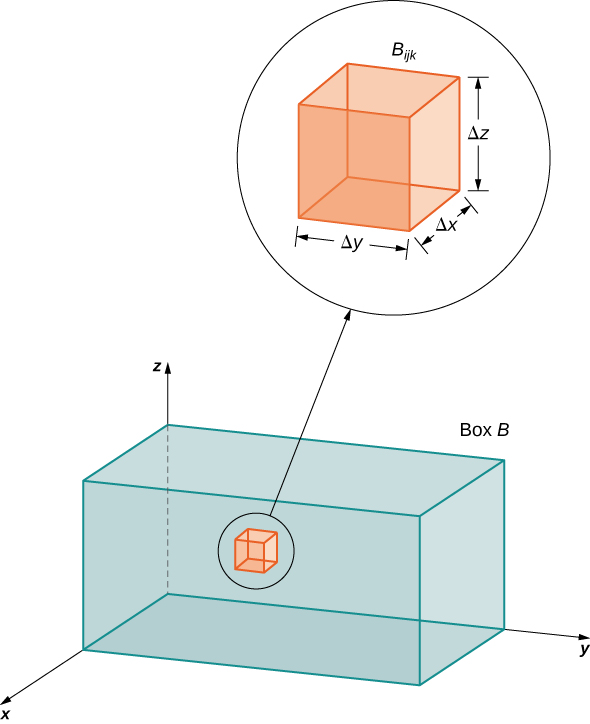
For each \(i, \, j,\) and \(grand\), consider a sample point \((x_{ijk}^*, y_{ijk}^*, z_{ijk}^*)\) in each sub-box \(B_{ijk}\). We run across that its book is \(\Delta V = \Delta 10 \Delta y \Delta z\). Form the triple Riemann sum
\[\sum_{i=1}^l \sum_{j=one}^grand \sum_{k=one}^n f ( x_{ijk}^*, y_{ijk}^*, z_{ijk}^*)\,\Delta x \Delta y \Delta z.\]
We define the triple integral in terms of the limit of a triple Riemann sum, equally we did for the double integral in terms of a double Riemann sum.
Definition: The triple integral
The triple integral of a function \(f(ten,y,z)\) over a rectangular box \(B\) is defined every bit
\[\lim_{fifty,thousand,n\rightarrow\infty} \sum_{i=1}^l \sum_{j=1}^thou \sum_{k=1}^n f ( x_{ijk}^*, y_{ijk}^*, z_{ijk}^*)\,\Delta x \Delta y \Delta z = \iiint_B f(x,y,z) \,dV\] if this limit exists.
When the triple integral exists on \(B\) the function \(f(10,y,z)\) is said to be integrable on \(B\). Also, the triple integral exists if \(f(x,y,z)\) is continuous on \(B\). Therefore, we volition utilize continuous functions for our examples. However, continuity is sufficient just not necessary; in other words, \(f\) is divisional on \(B\) and continuous except mayhap on the boundary of \(B\). The sample point \((x_{ijk}^*, y_{ijk}^*, z_{ijk}^*)\) can be whatever point in the rectangular sub-box \(B_{ijk}\) and all the properties of a double integral employ to a triple integral. Only every bit the double integral has many practical applications, the triple integral likewise has many applications, which we discuss in later sections.
Now that we have developed the concept of the triple integral, we need to know how to compute it. Just equally in the instance of the double integral, we tin have an iterated triple integral, and consequently, a version of Fubini'south theorem for triple integrals exists.
Fubini's Theorem for Triple Integrals
If \(f(10,y,z)\) is continuous on a rectangular box \(B = [a,b] \times [c,d] \times [e,f]\), then
\[\iint_B f(10,y,z) \,dV = \int_e^f \int_c^d \int_a^b f(10,y,z) \,dx \, dy \, dz.\]
This integral is also equal to any of the other five possible orderings for the iterated triple integral.
For \(a, b, c, d, e\) and \(f\) real numbers, the iterated triple integral can be expressed in vi dissimilar orderings:
\[\begin{align} \int_e^f \int_c^d \int_a^b f(ten,y,z)\, dx \, dy \, dz = \int_e^f \left( \int_c^d \left( \int_a^b f(10,y,z) \,dx \right) dy \correct) dz \\ = \int_c^d \left( \int_e^f \left( \int_a^b f(ten,y,z) \,dx \correct)dz \right) dy \\ = \int_a^b \left( \int_e^f \left( \int_c^d f(x,y,z) \,dy \right)dz \correct) dx \\ = \int_e^f \left( \int_a^b \left( \int_c^d f(x,y,z) \,dy \correct) dx \correct) dz \\ = \int_c^d \left( \int_a^b \left( \int_c^d f(x,y,z) \,dz\right)dx \right) dy \\ = \int_a^b \left( \int_c^d \left( \int_e^f f(10,y,z) \,dz \right) dy \right) dx \cease{align}\]
For a rectangular box, the club of integration does not make any significant difference in the level of difficulty in computation. We compute triple integrals using Fubini's Theorem rather than using the Riemann sum definition. We follow the club of integration in the same way as we did for double integrals (that is, from within to outside).
Example \(\PageIndex{1}\): Evaluating a Triple Integral
Evaluate the triple integral \[\int_{z=0}^{z=one} \int_{y=two}^{y=iv} \int_{x=-one}^{10=5} (x + yz^ii)\, dx \, dy \, dz. \nonumber \]
Solution
The order of integration is specified in the problem, so integrate with respect to \(x\) first, then y, and and then \(z\).
\[\begin{align*} \int_{z=0}^{z=1} \int_{y=2}^{y=4} \int_{x=-1}^{x=5} (x + yz^2) \, dx \, dy \, dz \\ = \int_{z=0}^{z=one} \int_{y=2}^{y=four} \left. \left[ \dfrac{x^2}{2} + xyz^ii\correct|_{x=-1}^{10=five}\right]\, dy \, dz \text{Integrate with respect to $x$.} \\ = \int_{z=0}^{z=ane} \int_{y=2}^{y=four} \left[12+6yz^2\correct] \,dy \, dz \text{Evaluate.} \\ = \int_{z=0}^{z=one} \left[ \left.12y+6\dfrac{y^ii}{2}z^two \right|_{y=two}^{y=4} \right] dz \text{Integrate with respect to $y$.} \\ = \int_{z=0}^{z=1} [24+36z^ii] \, dz \text{Evaluate.} \\ = \left[ 24z+36\dfrac{z^iii}{3} \correct]_{z=0}^{z=1} \text{Integrate with respect to $z$.}\\ =36. \text{Evaluate.} \end{align*}\]
Example \(\PageIndex{2}\): Evaluating a Triple Integral
Evaluate the triple integral
\[\iiint_B x^2 yz \,dV\]
where \(B = \big\{(x,y,z)\,|\, - two \leq 10 \leq ane, \, 0 \leq y \leq 3, \, 1 \leq z \leq five \big\} \) every bit shown in Figure \(\PageIndex{2}\).
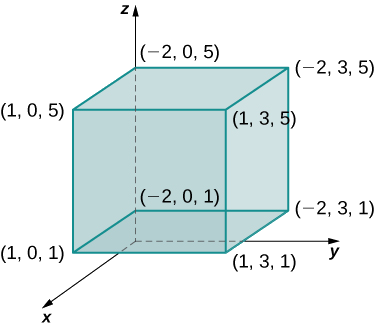
Solution
The order is not specified, simply we can use the iterated integral in whatsoever order without irresolute the level of difficulty. Choose, say, to integrate \(y\) first, then \(x\), then \(z\).
\[\begin{align*} \iiint\limits_{B} ten^2 yz \,dV = \int_1^5 \int_{-two}^1 \int_0^3 [x^ii yz] \,dy \, dx \, dz \\ = \int_1^five \int_{-2}^i \left[ \left. 10^two \dfrac{y^three}{iii} z\right|_0^iii \right] dx \, dz \\ = \int_1^5 \int_{-2}^ane \dfrac{y}{two} 10^2 z \,dx \, dz \\ = \int_1^five \left[ \left. \dfrac{nine}{2} \dfrac{10^3}{3} z \right|_{-2}^1 \right] dz = \int_1^5 \dfrac{27}{ii} z \, dz \\ = \left. \dfrac{27}{2} \dfrac{z^2}{2} \right|_1^5 = 162. \stop{align*}\]
Now try to integrate in a different society merely to run across that nosotros get the same answer. Choose to integrate with respect to \(ten\) first, so \(z\), then \(y\)
\[\begin{align*} \iiiint\limits_{B} ten^2yz \,dV = \int_0^3 \int_1^5 \int_{-two}^1 [x^2yz] \,dx\, dz\, dy \\ = \int_0^three \int_1^5 \left[ \left. \dfrac{x^iii}{3} yz \right|_{-2}^1 \right] dz \,dy \\ =\int_0^iii \int_1^v 3yz \; dz \,dy \\ = \int_0^3 \left.\left[ 3y\dfrac{z^ii}{2} \right|_1^v \correct] \,dy \\ = \int_0^three 36y \; dy \\ = \left. 36\dfrac{y^2}{2} \correct|_0^iii =xviii(ix-0) =162. \stop{marshal*}\]
Practise \(\PageIndex{ane}\)
Evaluate the triple integral
\[\iint_B z \, \sin \, x \, \cos \, y \, dV\nonumber \]
where \(B = \big\{(x,y,z)\,|\,0 \leq x \leq \pi, \, \dfrac{three\pi}{two} \leq y \leq 2\pi, \, 1 \leq z \leq 3 \big\}\).
- Hint
-
Follow the steps in the previous case.
- Answer
-
\[\iint_B z \, \sin \, x \, \cos \, y \, dV = eight \nonumber\]
Triple Integral over a General Region
The triple integral of a continuous function \(f(x,y,z)\) over a general three-dimensional region
\[E = \large\{(x,y,z)\,|\,(x,y) \in D, \, u_1(x,y) \leq z \leq u_2(x,y) \big\}\]
in \(\mathbb{R}^three\), where \(D\) is the projection of \(E\) onto the \(xy\)-airplane, is
\[\iiint_E f(x,y,z) \,dV = \iint_D \left[\int_{u_1(10,y)}^{u_2(10,y)} f(x,y,z) \,dz \right] \, dA.\]
Similarly, we tin can consider a general divisional region \(D\) in the \(xy\)-airplane and two functions \(y = u_1(ten,z)\) and \(y = u_2(ten,z)\) such that \(u_1(x,z) \leq u_2(10,z)\) for all \((10,z)\) in \(D\). So we can draw the solid region \(E\) in \(\mathbb{R}^iii\) as
\[E = \big\{(x,y,z)\,|\,(x,z) \in D, \, u_1(ten,z) \leq z \leq u_2(ten,z) \big\}\] where \(D\) is the projection of \(E\) onto the \(xy\)-plane and the triple integral is
\[\iiint_E f(x,y,z)\,dV = \iint_D \left[\int_{u_1(10,z)}^{u_2(x,z)} f(x,y,z) \,dy \right] \, dA.\]
Finally, if \(D\) is a full general bounded region in the \(xy\)-plane and we have two functions \(10 = u_1(y,z)\) and \(x = u_2(y,z)\) such that \(u_1(y,z) \leq u_2(y,z)\) for all \((y,z)\) in \(D\), and then the solid region \(E\) in \(\mathbb{R}^3\) can be described equally
\[E = \large\{(10,y,z)\,|\,(y,z) \in D, \, u_1(y,z) \leq z \leq u_2(y,z) \large\}\] where \(D\) is the projection of \(Due east\) onto the \(xy\)-plane and the triple integral is
\[\iiint_E f(x,y,z)\,dV = \iint_D \left[\int_{u_1(y,z)}^{u_2(y,z)} f(x,y,z) \, dx \correct] \, dA.\]
Note that the region \(D\) in whatever of the planes may be of Blazon I or Blazon Two as described in previously. If \(D\) in the \(xy\)-plane is of Type I (Figure \(\PageIndex{iv}\)), and then
\[Eastward = \big\{(x,y,z)\,|\,a \leq 10 \leq b, \, g_1(10) \leq y \leq g_2(x), \, u_1(x,y) \leq z \leq u_2(10,y) \big\}.\]
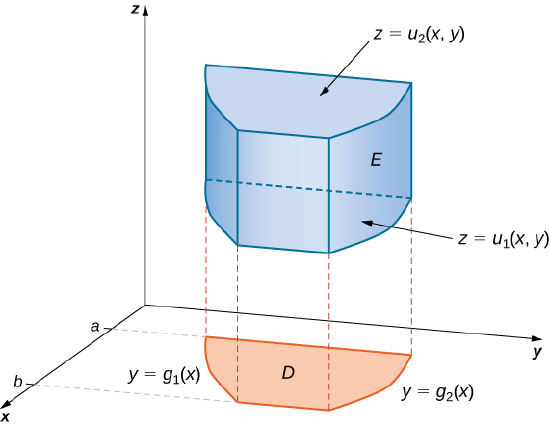
Then the triple integral becomes
\[\iiint_E f(x,y,z) \,dV = \int_a^b \int_{g_1(ten)}^{g_2(x)} \int_{u_1(x,y)}^{u_2(10,y)} f(x,y,z) \,dz \, dy \, dx.\]
If \(D\) in the \(xy\)-aeroplane is of Blazon II (Figure \(\PageIndex{5}\)), then
\[E = \big\{(x,y,z)\,|\,c \leq x \leq d, h_1(10) \leq y \leq h_2(x), \, u_1(x,y) \leq z \leq u_2(10,y) \big\}.\]
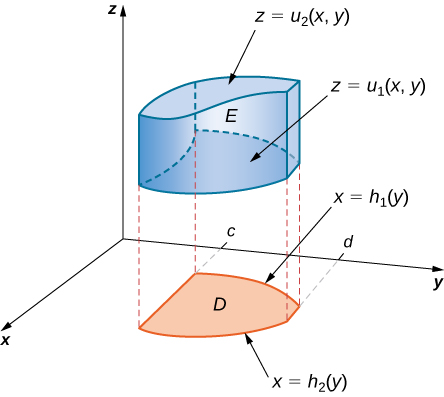
Then the triple integral becomes
\[\iiint_E f(10,y,z) \,dV = \int_{y=c}^{y=d} \int_{x=h_1(y)}^{x=h_2(y)} \int_{z=u_1(x,y)}^{z=u_2(x,y)} f(ten,y,z)\,dz \, dx \, dy.\]
Example \(\PageIndex{3A}\): Evaluating a Triple Integral over a General Bounded Region
Evaluate the triple integral of the function \(f(x,y,z) = 5x - 3y\) over the solid tetrahedron divisional by the planes \(ten = 0, \, y = 0, \, z = 0\), and \(x + y + z = one\).
Solution
Figure \(\PageIndex{6}\) shows the solid tetrahedron \(Due east\) and its projection \(D\) on the \(xy\)-airplane.
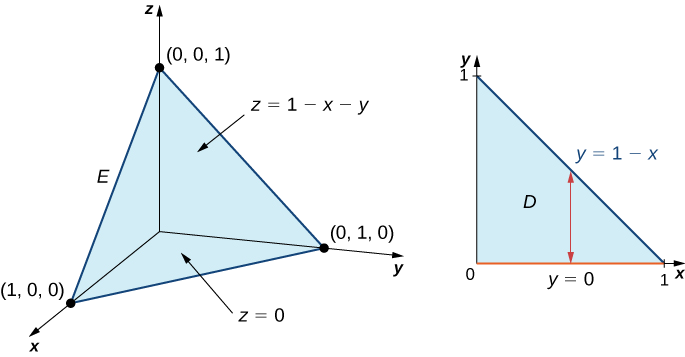
Nosotros can describe the solid region tetrahedron every bit
\[E = \large\{(10,y,z)\,|\,0 \leq x \leq 1, \, 0 \leq y \leq 1 - 10, \, 0 \leq z \leq 1 - x - y \big\}. \nonumber\]
Hence, the triple integral is
\[\iiint_E f(x,y,z) \,dV = \int_{x=0}^{x=1} \int_{y=0}^{y=i-x} \int_{z=0}^{z=1-10-y} (5x - 3y) \,dz \, dy \, dx. \nonumber\]
To simplify the adding, kickoff evaluate the integral \(\displaystyle \int_{z=0}^{z=ane-x-y} (5x - 3y) \,dz\). We have
\[\int_{z=0}^{z=1-ten-y} (5x - 3y) \,dz = (5x - 3y)z \bigg|_{z=0}^{z=1-ten-y} = (5x - 3y)(1 - x - y).\nonumber\]
Now evaluate the integral
\[\int_{y=0}^{y=1-x} (5x - 3y)(1 - x - y) \,dy, \nonumber\]
obtaining
\[\int_{y=0}^{y=1-x} (5x - 3y)(1 - x - y)\,dy = \dfrac{one}{2}(ten - 1)^ii (6x - i).\nonumber\]
Finally evaluate
\[\int_{10=0}^{x=1} \dfrac{1}{two}(ten - 1)^ii (6x - 1)\,dx = \dfrac{1}{12}.\nonumber\]
Putting information technology all together, we have
\[\iiint_E f(x,y,z)\,dV = \int_{x=0}^{x=1} \int_{y=0}^{y=1-10} \int_{z=0}^{z=i-x-y}(5x - 3y)\,dz \, dy \, dx = \dfrac{1}{12}.\nonumber\]
Just as we used the double integral \[\iint_D 1 \,dA\] to find the area of a full general bounded region \(D\) we tin utilize \[\iiint_E 1\,dV\] to observe the volume of a general solid bounded region \(E\). The next example illustrates the method.
Example \(\PageIndex{3B}\): Finding a Volume past Evaluating a Triple Integral
Detect the volume of a right pyramid that has the square base in the \(xy\)-airplane \([-1,one] \times [-1,1]\) and vertex at the point \((0, 0, 1)\) as shown in the following effigy.
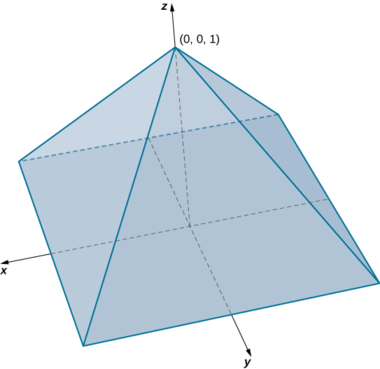
Solution
In this pyramid the value of \(z\) changes from 0 to 1 and at each meridian \(z\) the cross section of the pyramid for any value of \(z\) is the foursquare
\[[-1 + z, \, 1 - z] \times [-1 + z, \, 1 - z].\nonumber\]
Hence, the volume of the pyramid is \[\iiint_E 1\,dV\nonumber\] where
\[E = \big\{(x,y,z)\,|\,0 \leq z \leq 1, \, -i + z \leq y \leq 1 - z, \, -one + z \leq x \leq 1 - z \big\}.\nonumber\]
Thus, nosotros accept
\[\begin{align*} \iiint_E 1\,dV = \int_{z=0}^{z=one} \int_{y=-one+z}^{y=one-z} \int_{ten=-1+z}^{x=i-z} 1\,dx \, dy \, dz \\ = \int_{z=0}^{z=ane} \int_{y=-1+z}^{y=1-z} (ii - 2z)\, dy \, dz \\ = \int_{z=0}^{z=i}(2 - 2z)^2 \,dz = \dfrac{four}{iii}. \stop{marshal*}\]
Hence, the volume of the pyramid is \(\dfrac{4}{3}\) cubic units.
Exercise \(\PageIndex{three}\)
Consider the solid sphere \(Eastward = \big\{(ten,y,z)\,|\,x^2 + y^2 + z^2 = 9 \large\}\). Write the triple integral \[\iiint_E f(ten,y,z) \,dV\nonumber \] for an arbitrary function \(f\) as an iterated integral. Then evaluate this triple integral with \(f(x,y,z) = 1\). Notice that this gives the volume of a sphere using a triple integral.
- Hint
-
Follow the steps in the previous instance. Use symmetry.
- Answer
-
\[\begin{marshal*} \iiint_E 1\,dV = 8 \int_{x=-three}^{10=iii} \int_{y=-\sqrt{9-z^2}}^{y=\sqrt{9-z^2}}\int_{z=-\sqrt{9-x^ii-y^2}}^{z=\sqrt{9-x^2-y^two}} 1\,dz \, dy \, dx \\ = 36 \pi \,\text{cubic units}. \end{align*}\]
Changing the Order of Integration
Every bit we have already seen in double integrals over general divisional regions, irresolute the order of the integration is done quite oft to simplify the computation. With a triple integral over a rectangular box, the order of integration does not change the level of difficulty of the calculation. However, with a triple integral over a general bounded region, choosing an advisable lodge of integration tin simplify the computation quite a bit. Sometimes making the modify to polar coordinates can besides be very helpful. We demonstrate 2 examples hither.
Example \(\PageIndex{iv}\): Changing the Order of Integration
Consider the iterated integral
\[\int_{x=0}^{x=ane} \int_{y=0}^{y=x^2} \int_{z=0}^{z=y} f(ten,y,z)\,dz \, dy \, dx.\]
The club of integration here is offset with respect to z, then y, so ten. Express this integral by changing the club of integration to be get-go with respect to \(x\), then \(z\), and so \(y\). Verify that the value of the integral is the same if we let \(f (x,y,z) =xyz\).
Solution
The all-time way to practise this is to sketch the region \(E\) and its projections onto each of the three coordinate planes. Thus, permit
\[E = \large\{(10,y,z)\,|\,0 \leq x \leq 1, \, 0 \leq y \leq x^two, \, 0 \leq z \leq y \big\}.\nonumber\]
and
\[\int_{ten=0}^{ten=1} \int_{y=0}^{y=ten^two} \int_{z=0}^{z=x^two} f(10,y,z) \,dz \, dy \, dx = \iiint_E f(x,y,z)\,dV.\nonumber\]
Nosotros need to express this triple integral as
\[\int_{y=c}^{y=d} \int_{z=v_1(y)}^{z=v_2(y)} \int_{x=u_1(y,z)}^{ten=u_2(y,z)} f(x,y,z)\,dx \, dz \, dy.\nonumber\]
Knowing the region \(E\) we can describe the following projections (Effigy \(\PageIndex{eight}\)):
on the \(xy\)-airplane is \(D_1 = \big\{(x,y)\,|\, 0 \leq x \leq i, \, 0 \leq y \leq 10^2 \big\} = \{ (10,y) \,|\, 0 \leq y \leq 1, \, \sqrt{y} \leq x \leq 1 \big\},\)
on the \(yz\)-plane is \(D_2 = \big\{(y,z) \,|\, 0 \leq y \leq 1, \, 0 \leq z \leq y^2 \big\}\), and
on the \(xz\)-airplane is \(D_3 = \big\{(ten,z) \,|\, 0 \leq x \leq one, \, 0 \leq z \leq x^2 \big\}\).

Now we can describe the same region \(E\) as \(\large\{(x,y,z) \,|\, 0 \leq y \leq 1, \, 0 \leq z \leq y^ii, \, \sqrt{y} \leq ten \leq i \large\}\), and consequently, the triple integral becomes
\[\int_{y=c}^{y=d} \int_{z=v_1(y)}^{z=v_2(y)} \int_{ten=u_1(y,z)}^{ten=u_2(y,z)} f(x,y,z)\,dx \, dz \, dy = \int_{y=0}^{y=1} \int_{z=0}^{z=x^2} \int_{10=\sqrt{y}}^{x=ane} f(x,y,z)\,dx \, dz \, dy\]
Now presume that \(f (x,y,z) = xyz\) in each of the integrals. Then we have
\[\begin{align*} \int_{10=0}^{x=i} \int_{y=0}^{y=x^2} \int_{z=0}^{z=y^2} xyz \, dz \, dy \, dx \\ = \int_{x=0}^{x=one} \int_{y=0}^{y=10^2} \left. \left[xy \dfrac{z^2}{2} \correct|_{z=0}^{z=y^ii} \right] \, dy \, dx = \int_{x=0}^{x=1} \int_{y=0}^{y=x^2} \left( x \dfrac{y^5}{ii}\right) dy \, dx = \int_{x=0}^{10=1} \left. \left[ x\dfrac{y^half dozen}{12} \correct|_{y=0}^{y=x^2}\right] dx = \int_{x=0}^{x=1} \dfrac{x^{13}}{12} dx = \left. \dfrac{x^{14}}{168}\right|_{x=0}^{10=ane} = \dfrac{1}{168}, \end{marshal*}\]
\[ \begin{align*} \int_{y=0}^{y=i} \int_{z=0}^{z=y^2} \int_{ten=\sqrt{y}}^{10=i} xyz \, dx \, dz \, dy \\ = \int_{y=0}^{y=1} \int_{z=0}^{z=y^2} \left.\left[yz \dfrac{x^two}{2} \right|_{\sqrt{y}}^{i} \correct] dz \, dy = \int_{y=0}^{y=1} \int_{z=0}^{z=y^2} \left( \dfrac{yz}{2} - \dfrac{y^2z}{two} \correct) dz \, dy = \int_{y=0}^{y=1} \left. \left[ \dfrac{yz^ii}{4} - \dfrac{y^2z^two}{four} \correct|_{z=0}^{z=y^2} \right] dy = \int_{y=0}^{y=1} \left(\dfrac{y^5}{4} - \dfrac{y^6}{four} \correct) dy = \left. \left(\dfrac{y^vi}{24} - \dfrac{y^7}{28} \correct) \right|_{y=0}^{y=ane} = \dfrac{1}{168}. \terminate{align*} \]
The answers match.
Practice \(\PageIndex{four}\)
Write five different iterated integrals equal to the given integral
\[\int_{z=0}^{z=4} \int_{y=0}^{y=4-z} \int_{x=0}^{ten=\sqrt{y}} f(x,y,z) \, dx \, dy \, dz.\nonumber\]
- Hint
-
Follow the steps in the previous example, using the region \(E\) as \( \big\{(10,y,z) \,|\, 0 \leq z \leq 4, \, 0 \leq y \leq 4 - z, \, 0 \leq x \leq \sqrt{y} \large\}\), and depict and sketch the projections onto each of the 3 planes, five different times.
- Answer
-
\[(i) \, \int_{z=0}^{z=four} \int_{x=0}^{x=\sqrt{4-z}} \int_{y=x^2}^{y=four-z} f(10,y,z) \, dy \, dx \, dz, \, (ii) \, \int_{y=0}^{y=4} \int_{z=0}^{z=four-y} \int_{x=0}^{x=\sqrt{y}} f(ten,y,z) \,dx \, dz \, dy, \,(three) \, \int_{y=0}^{y=4} \int_{x=0}^{x=\sqrt{y}} \int_{z=0}^{Z=4-y} f(x,y,z) \,dz \, dx \, dy, \, \nonumber\]
\[ (four) \, \int_{10=0}^{x=2} \int_{y=x^2}^{y=4} \int_{z=0}^{z=4-y} f(x,y,z) \,dz \, dy \, dx, \, (v) \int_{x=0}^{x=2} \int_{z=0}^{z=4-x^2} \int_{y=x^2}^{y=4-z} f(x,y,z) \,dy \, dz \, dx \nonumber\]
Example \(\PageIndex{five}\): Changing Integration Guild and Coordinate Systems
Evaluate the triple integral
\[\iiint_{East} \sqrt{x^2 + z^ii} \,dV, \nonumber \]
where \(E\) is the region bounded by the paraboloid \(y = 10^2 + z^2\) (Effigy \(\PageIndex{nine}\)) and the airplane \(y = 4\).
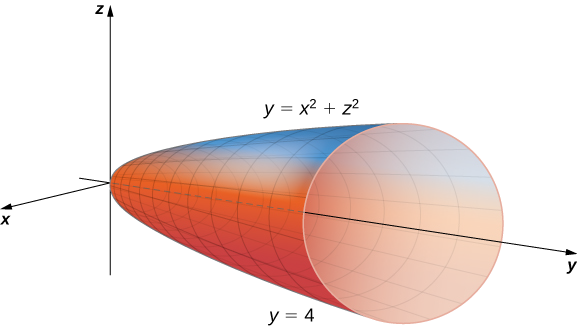
Solution
The projection of the solid region \(E\) onto the \(xy\)-airplane is the region bounded higher up by \(y = 4\) and below by the parabola \(y = x^two\) equally shown.
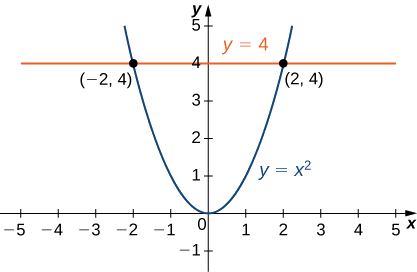
Thus, nosotros accept
\[E = \big\{(10,y,z) \,|\, -ii \leq 10 \leq 2, \, x^2 \leq y \leq 4, \, -\sqrt{y - x^two} \leq z \sqrt{y - x^2} \large\}.\nonumber\]
The triple integral becomes
\[\iiint_E \sqrt{x^2 + z^2} \,dV = \int_{x=-two}^{x=2} \int_{y=x^two}^{y=4} \int_{z=-\sqrt{y-x^2}}^{z=\sqrt{y-x^two}} \sqrt{x^2 + z^two} \,dz \, dy \, dx.\nonumber\]
This expression is difficult to compute, so consider the projection of \(East\) onto the \(xz\)-airplane. This is a round disc \(x^2 + z^2 \leq four\). And so nosotros obtain
\[\iiint_E \sqrt{x^ii + z^ii} \,dV = \int_{x=-ii}^{x=two} \int_{y=x^2}^{y=iv} \int_{z=-\sqrt{y-ten^2}}^{z=\sqrt{y-10^2}} \sqrt{x^2 + z^2} \,dz \, dy \, dx = \int_{10=-ii}^{x=two} \int_{z=-\sqrt{4-x^two}}^{z=\sqrt{4-x^two}} \int_{y=10^2+z^two}^{y=4} \sqrt{x^2 + z^2} \,dy \, dz \, dx.\nonumber\]
Here the club of integration changes from being get-go with respect to \(z\) then \(y\) and then \(ten\) to being starting time with respect to \(y\) then to \(z\) and and so to \(x\). It volition soon be clear how this change tin can exist beneficial for computation. Nosotros have
\[\int_{ten=-two}^{x=2} \int_{z=\sqrt{4-x^2}}^{z=\sqrt{4-x^2}} \int_{y=ten^2+z^2}^{y=4} \sqrt{10^2 + z^2} \,dy \, dz \, dx = \int_{x=-2}^{x=2} \int_{z=-\sqrt{4-10^two}}^{z=\sqrt{four-x^two}} (4 - ten^2 - z^2) \sqrt{x^2 + z^2} \,dz \, dx.\nonumber\]
At present employ the polar substitution \(10 = r \, \cos \, \theta, \, z = r \, \sin \, \theta\), and \(dz \, dx = r \, dr \, d\theta\) in the \(xz\)-plane. This is essentially the same thing as when nosotros used polar coordinates in the \(xy\)-plane, except we are replacing \(y\) past \(z\). Consequently the limits of integration modify and we have, by using \(r^2 = x^2 + z^ii\),
\[\int_{x=-ii}^{x=2} \int_{z=-\sqrt{iv-x^2}}^{z=\sqrt{four-x^2}} (4 - x^2 - z^2) \sqrt{x^2 + z^2}\,dz \, dx = \int_{\theta=0}^{\theta=2\pi} \int_{r=0}^{r=ii} (4 - r^two) rr \, dr \, d\theta = \int_0^{2\pi} \left. \left[ \dfrac{4r^three}{3} - \dfrac{r^five}{5} \correct|_0^two \right] \, d\theta = \int_0^{2\pi} \dfrac{64}{15} \,d\theta = \dfrac{128\pi}{fifteen}\nonumber\]
Average Value of a Function of Iii Variables
Remember that nosotros found the boilerplate value of a function of two variables by evaluating the double integral over a region on the plane and then dividing by the area of the region. Similarly, we can find the average value of a office in three variables past evaluating the triple integral over a solid region and so dividing by the volume of the solid.
Average Value of a Function of Three Variables
If \(f(x,y,z)\) is integrable over a solid bounded region \(E\) with positive volume \(V \, (Due east),\) then the average value of the office is
\[f_{ave} = \dfrac{1}{Five \, (Eastward)} \iiint_E f(x,y,z) \, dV.\]
Note that the volume is
\[5 \, (Eastward) = \iiint_E ane \,dV.\]
Example \(\PageIndex{half dozen}\): Finding an Boilerplate Temperature
The temperature at a point \((x,y,z)\) of a solid \(E\) divisional by the coordinate planes and the airplane \(x + y + z = 1\) is \(T(x,y,z) = (xy + 8z + 20) \, \text{°}\text{C} \). Discover the average temperature over the solid.
Solution
Employ the theorem given higher up and the triple integral to discover the numerator and the denominator. Then do the segmentation. Find that the airplane \(x + y + z = 1\) has intercepts \((i,0,0), \, (0,1,0),\) and \((0,0,1)\). The region \(Due east\) looks like
\[Due east = \big\{(10,y,z) \,|\, 0 \leq x \leq one, \, 0 \leq y \leq i - ten, \, 0 \leq z \leq one - x - y \big\}.\nonumber\]
Hence the triple integral of the temperature is
\[\iiint_E f(10,y,z) \,dV = \int_{x=0}^{x=1} \int_{y=0}^{y=i-x} \int_{z=0}^{z=ane-x-y} (xy + 8z + 20) \, dz \, dy \, dx = \dfrac{147}{forty}. \nonumber \]
The volume evaluation is
\[V \, (East) = \iiint_E 1\,dV = \int_{x=0}^{x=1} \int_{y=0}^{y=1-x} \int_{z=0}^{z=1-x-y} 1 \,dz \, dy \, dx = \dfrac{one}{half-dozen}. \nonumber \]
Hence the boilerplate value is
\[ T_{ave} = \dfrac{147/xl}{one/half-dozen} = \dfrac{6(147)}{40} = \dfrac{441}{twenty} \, \text{°}\text{C} \nonumber\].
Exercise \(\PageIndex{6}\)
Notice the average value of the part \(f(x,y,z) = xyz\) over the cube with sides of length four units in the first octant with one vertex at the origin and edges parallel to the coordinate axes.
- Hint
-
Follow the steps in the previous case.
- Answer
-
\(f_{ave} = viii\)
thomashastannow54.blogspot.com
Source: https://math.libretexts.org/Bookshelves/Calculus/Book:_Calculus_%28OpenStax%29/15:_Multiple_Integration/15.4:_Triple_Integrals
Post a Comment for "We Can Again Express the Volume of the Solid Enclosed by the Parab"